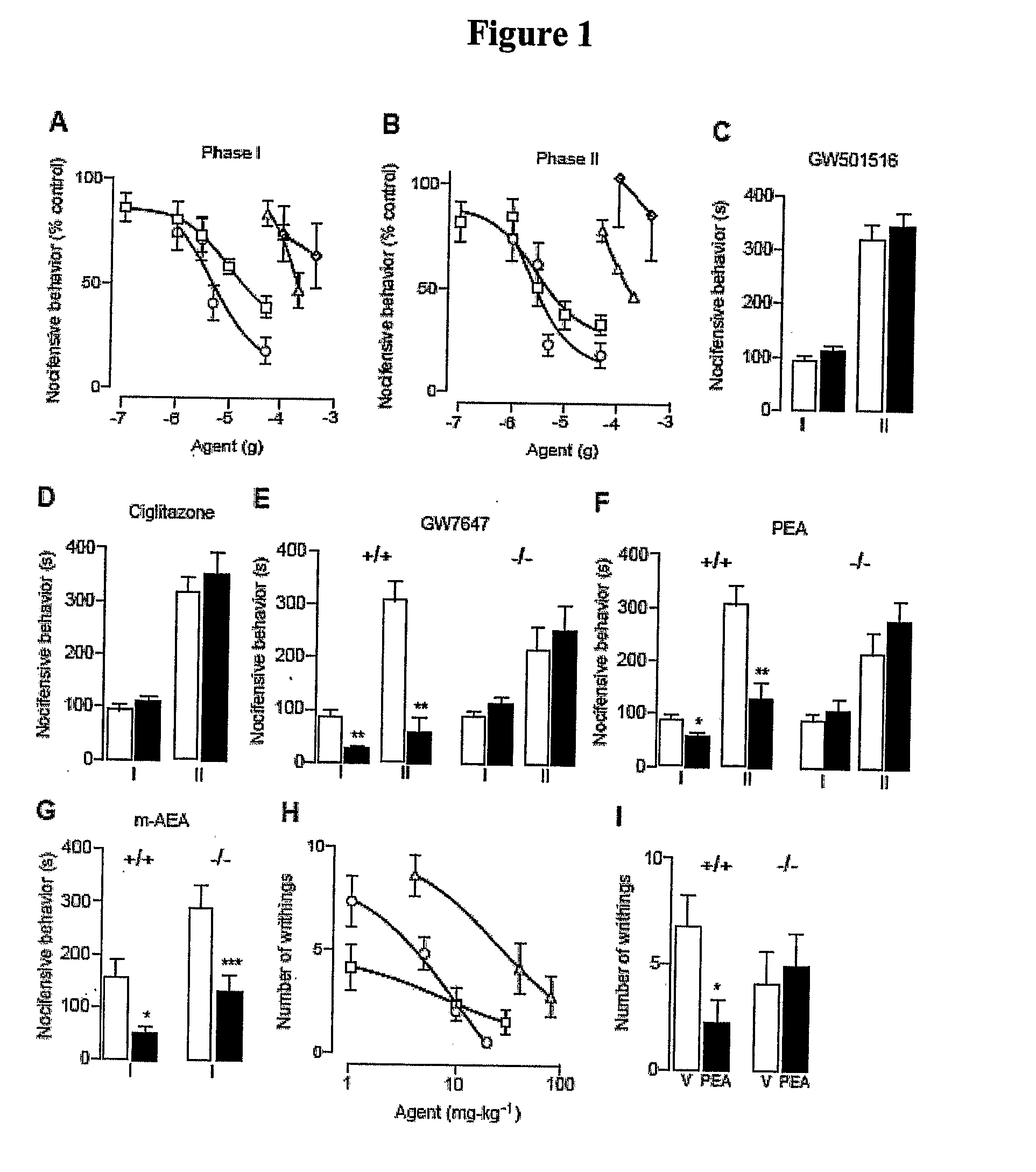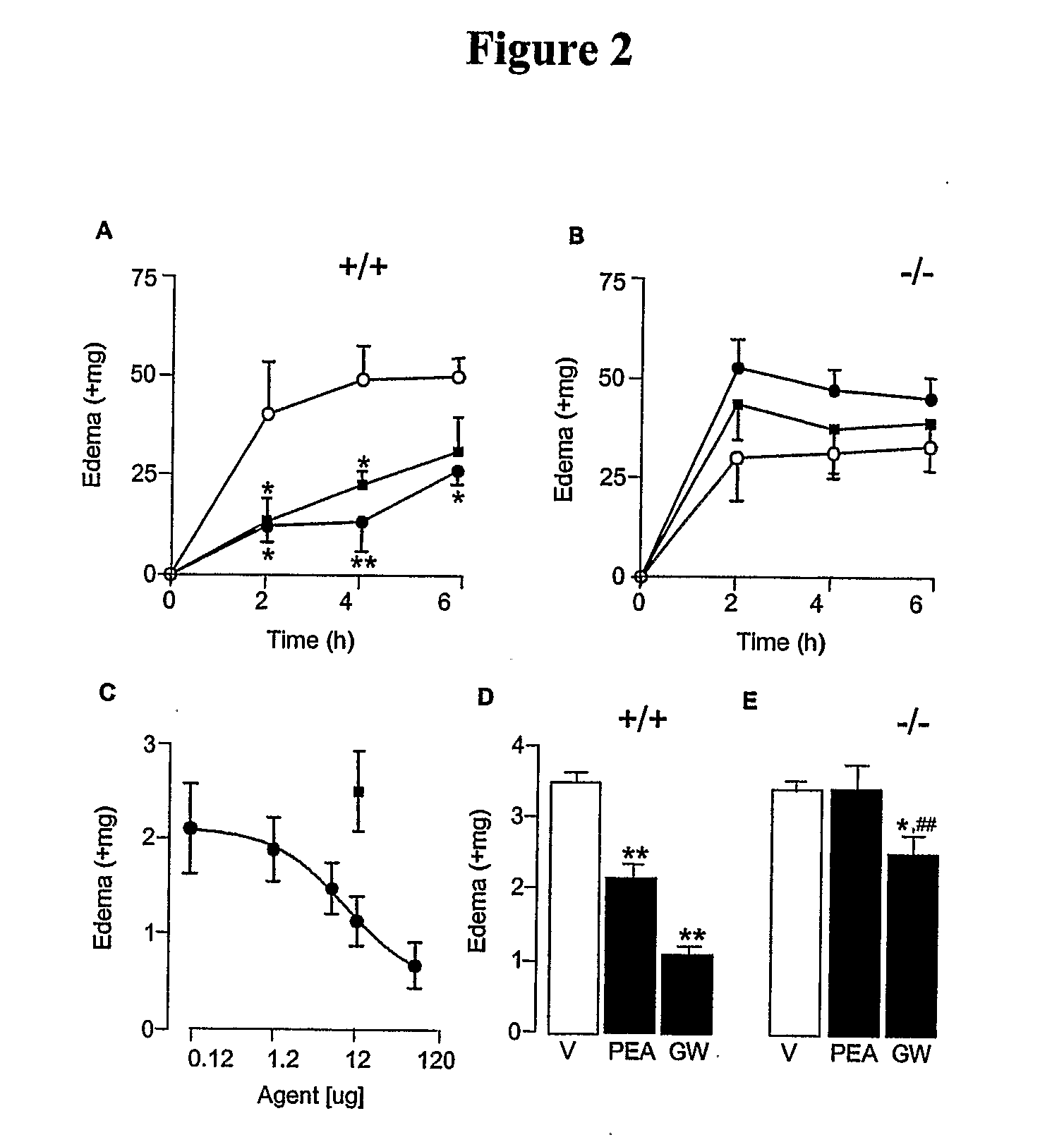Compounds And Methods For Treating Non-Inflammatory Pain Using Ppar Alpha Agonists
a non-inflammatory pain and agonist technology, applied in the field of compounds and methods for treating non-inflammatory pain using ppar alpha agonists, can solve the problems of undefined mechanism by which these effects occur, high debatable evidence, and alter the sensitivity of the nervous system to nociception, so as to inhibit the faah-mediated hydrolysis and increase the biological half-life of oea-like compounds
- Summary
- Abstract
- Description
- Claims
- Application Information
AI Technical Summary
Benefits of technology
Problems solved by technology
Method used
Image
Examples
example 1
Role of PPARα in Modulating Pain
[0411]Administration of formalin into the mouse hind paw evokes a pain behavior consisting of two temporally distinct phases of licking and flexing of the injected limb (Dubuisson, et al., Pain 4, 161-74 (1977)). The first phase, which starts immediately after formalin injection and lasts 5-10 min, is due to activation of nociceptive fibers and is accompanied by the local release of nitric oxide and adenosine [Dickenson, et al., Neurosci Lett 83, 207-11 (1987); Omote, et al., Brain Res 787, 161-4 (1998); Omote et al., 2000; Liu, et al., J Neurochem 80, 562-70 (2002)]. Following a quiescent interval of 10-15 minutes, a second phase of nociceptive behavior appears, which is associated with local inflammation [Rosland, et al., Pain 42, 235-42 (1990)] and central sensitization [Coderre, et al., J Neurosci 12, 3665-70 (1992)]. PEA attenuates both phases in a dose-dependent manner [Calignano, et al., Nature 394, 277-81 (1998); Calignano, et al., Prog Brain ...
example 2
Use of PPARα Agonists to Decrease Neuropathic Hyperalgesia Following Partial Sciatic Nerve Injury in the Rat
[0427]This prophetic example illustrates the topical use of PPARα agonists to treat pain that is primarily not the result of inflammation, e.g. neuropathic pain. Male Sprague-Dawley rats (180-250 g) are anaesthetised with 50 mg / kg i.p. pentobarbitone sodium (Nembutal). The unilateral common sciatic nerve is exposed high in the thigh and ⅓-½ of the nerve trunk is carefully separated and tightly ligated using a siliconised silk suture (Ethicone 8-0). Then the wound is closed and the animals are allowed to survive for 8 days. During this period, signs of spontaneous pain (holding the legs in elevated position) and mechano-nociceptive hyperalgesia develop. Mechano-nociception of the hindpaws is measured by Randall-Selitto test using the Ugo Basile analgesimeter. Continuously increasing pressure is applied on the paw of conscious rats and the threshold force which elicits withdrawa...
example 3
Combination of CB1 and PPARα Agonists Decrease Neuropathic Hyperalgesia Following Partial Sciatic Nerve Injury in the Rat
[0428]This prophetic example further illustrates the topical administration of the combination of a PPARα agonist and a CB1 agonist to treat pain. Partial sciatic nerve injury is created and mechano-nociception of the hind paws is measured in male Sprague-Dawley rats as described in Example 2. Measurements on the 7th day are taken 1.5-2 h before and 30 min after topical administration of the combination of PPARα agonists and CB1 agonists. Combinations of a single CB1 agonist and a single PPARα agonist are administered topically (on the effected paw). CB1 agonists that are used include anandamide (AEA), WIN-55212-2 and HU-210. PPARα agonists that are used include PEA, OEA, GW-7647 and WY-14643. The appropriate solvent(s) is also topically applied on rats to serve as a control. Changes of mechano-nociceptive thresholds in percentage compared to the respective preope...
PUM
| Property | Measurement | Unit |
|---|---|---|
| Molar density | aaaaa | aaaaa |
| Fraction | aaaaa | aaaaa |
| Fraction | aaaaa | aaaaa |
Abstract
Description
Claims
Application Information
 Login to View More
Login to View More - R&D
- Intellectual Property
- Life Sciences
- Materials
- Tech Scout
- Unparalleled Data Quality
- Higher Quality Content
- 60% Fewer Hallucinations
Browse by: Latest US Patents, China's latest patents, Technical Efficacy Thesaurus, Application Domain, Technology Topic, Popular Technical Reports.
© 2025 PatSnap. All rights reserved.Legal|Privacy policy|Modern Slavery Act Transparency Statement|Sitemap|About US| Contact US: help@patsnap.com



